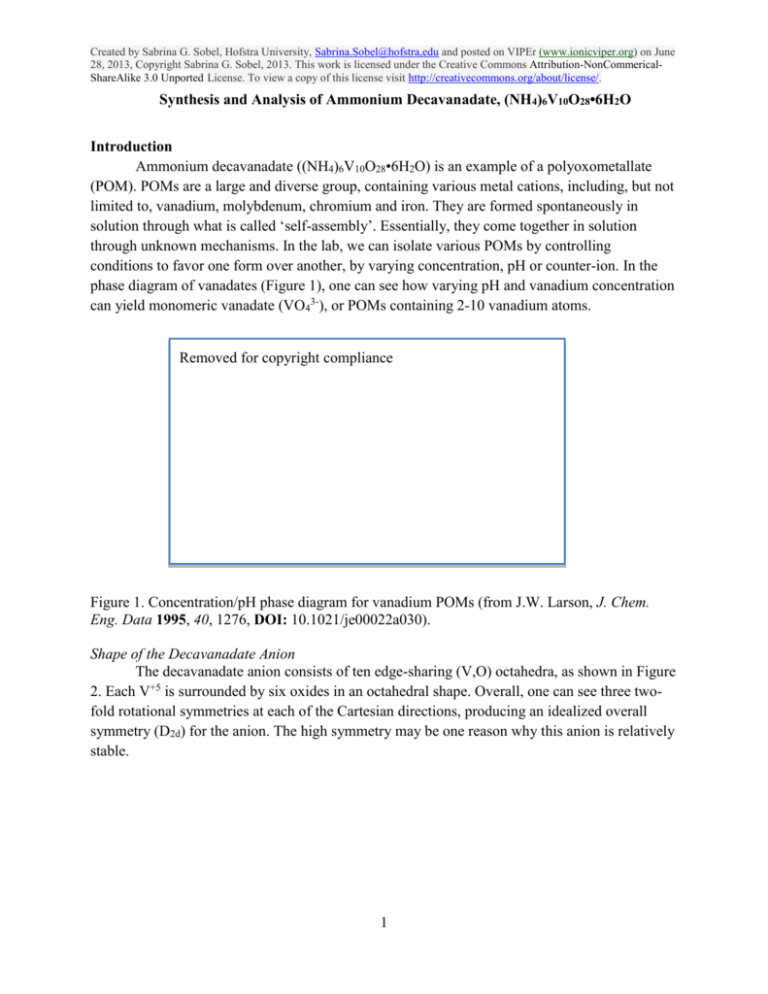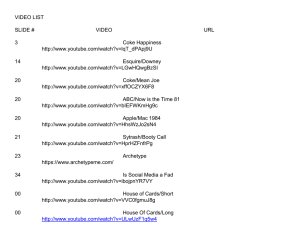Student Handout 20130627
advertisement

Created by Sabrina G. Sobel, Hofstra University, Sabrina.Sobel@hofstra,edu and posted on VIPEr (www.ionicviper.org) on June 28, 2013, Copyright Sabrina G. Sobel, 2013. This work is licensed under the Creative Commons Attribution-NonCommericalShareAlike 3.0 Unported License. To view a copy of this license visit http://creativecommons.org/about/license/. Synthesis and Analysis of Ammonium Decavanadate, (NH4)6V10O28•6H2O Introduction Ammonium decavanadate ((NH4)6V10O28•6H2O) is an example of a polyoxometallate (POM). POMs are a large and diverse group, containing various metal cations, including, but not limited to, vanadium, molybdenum, chromium and iron. They are formed spontaneously in solution through what is called ‘self-assembly’. Essentially, they come together in solution through unknown mechanisms. In the lab, we can isolate various POMs by controlling conditions to favor one form over another, by varying concentration, pH or counter-ion. In the phase diagram of vanadates (Figure 1), one can see how varying pH and vanadium concentration can yield monomeric vanadate (VO43-), or POMs containing 2-10 vanadium atoms. Removed for copyright compliance Figure 1. Concentration/pH phase diagram for vanadium POMs (from J.W. Larson, J. Chem. Eng. Data 1995, 40, 1276, DOI: 10.1021/je00022a030). Shape of the Decavanadate Anion The decavanadate anion consists of ten edge-sharing (V,O) octahedra, as shown in Figure 2. Each V+5 is surrounded by six oxides in an octahedral shape. Overall, one can see three twofold rotational symmetries at each of the Cartesian directions, producing an idealized overall symmetry (D2d) for the anion. The high symmetry may be one reason why this anion is relatively stable. 1 Created by Sabrina G. Sobel, Hofstra University, Sabrina.Sobel@hofstra,edu and posted on VIPEr (www.ionicviper.org) on June 28, 2013, Copyright Sabrina G. Sobel, 2013. This work is licensed under the Creative Commons Attribution-NonCommericalShareAlike 3.0 Unported License. To view a copy of this license visit http://creativecommons.org/about/license/. Figure 2. The decavanadate anion. Decavanadate in Geology The decavanadate anion occurs naturally in minerals, huemulite Na4Mg2V10O28•24H2O, hummerite (KMg)2V10O28•16H2O, lasalite (NaMg)2V10O28•20H2O , pascoite Ca3V10O28•16H2O, magnesiopascoite Ca2MgV10O28•16H2O, and rauvite Ca(UO2)2V10O28•16H2O, which differ in the cations and amount of hydration. As you can see from Figure 3, the dominant color is yellow-orange. This is due to the presence of the decavanadate anion, which is yellow-orange. All of the vanadium POMs and vanadate are yellow-orange due to charge-transfer bands in the 200 – 500 nm range. Vanadium is in the +5 oxidation state, which means that it has an electron configuration [Ar]3d0, termed a “ d0 ” transition metal ion. With no electrons in the 3d orbitals, the possibility for color being generated by d d internal transitions is absent. Instead, the color seen here is generated by the transfer of electron density from the oxide anions to the V+5 cations, termed charge-transfer. Removed for copyright complaince Figure 3. The minerals hummerite (A), pascoite (B) and magnesiopascoite (C), from www.mindat.org. 2 Created by Sabrina G. Sobel, Hofstra University, Sabrina.Sobel@hofstra,edu and posted on VIPEr (www.ionicviper.org) on June 28, 2013, Copyright Sabrina G. Sobel, 2013. This work is licensed under the Creative Commons Attribution-NonCommericalShareAlike 3.0 Unported License. To view a copy of this license visit http://creativecommons.org/about/license/. Decavanadate in Biology Vanadate (VO43-) is isostructural and isoelectronic with phosphate (PO43-) (Figure 4). 3- 3- O O V O P O O O O O Figure 4. Schematic drawings of vanadate and phosphate, showing tetrahedral coordination. For this reason, vanadate has found interest with researchers studying the role of phosphate in biological systems, such as in insulin uptake in cells. In addition, decavanadate has been used to bind to biologically relevant molecules, such as gelatin, cytosine, estrogen receptor, and myosin. Laboratory Experiment In this experiment, you will synthesize (NH4)6V10O28•6H2O from ammonium metavanadate (NH4VO3), and analyze the resultant product for purity via UV-Vis spectroscopy and permanganate titration. The self-assembly of the decavanadate occurs according to Figure 5. Figure 5. Self-assembly of decavanadate as a function of changing pH. Permanganate titration involves first the reduction of V5+ in decavanadate (orange) to V4+ in vanadyl cation (blue) using sulfurous acid (eqn. 1). Then, the vanadyl cation is titrated with purple permanganate to form pale yellow vanadate and colorless Mn2+ (eqn. 2). V10O286- + H2SO3 VO2+ + SO3 (g) (1) VO2+ + MnO4- VO2+ + Mn2+ (2) 3 Created by Sabrina G. Sobel, Hofstra University, Sabrina.Sobel@hofstra,edu and posted on VIPEr (www.ionicviper.org) on June 28, 2013, Copyright Sabrina G. Sobel, 2013. This work is licensed under the Creative Commons Attribution-NonCommericalShareAlike 3.0 Unported License. To view a copy of this license visit http://creativecommons.org/about/license/. Synthesis of (NH4)6V10O28•6H2O Weigh out 0.3g of NH4VO3 into a 50. mL beaker. Add 5 mL DI H2O with stirring and gentle heat. After the NH4VO3 slurry has turned yellow, add 0.4 mL 50% aqueous acetic acid solution with stirring. Add 15. mL 95% ethanol with stirring. Put on an ice bath for 15 minutes. Gravity filter the solid and wash with two 1.5 mL portions of ice-cold ethanol. Set aside to dry. When dry, weigh into a clean vial and calculate percent yield. UV-Vis Analysis of (NH4)6V10O28•6H2O Dissolve 0.1g of your product into DI water using a clean 100. mL volumetric flask. Transfer to a clean 250 mL Erlenmeyer flask. Label this Solution A. Transfer 10.0 mL of solution A back into the volumetric flask, and dilute to 100. mL. Label this Solution B. Create five Beer’s Law dilutions from two burets (stock decavanadate (2.0 x 10-4 M) and DI H2O); 5:0, 4:1, 3:2, 2:3, 1:4, in small test tubes. With the spectrophotometer set to 400 nm, determine the absorbance values of the standard decavanandate solutions, most dilute to most concentrated, and your solution B. Calculate the percent vanadium in your product and compare it to the theoretical value. IR Analysis Obtain an IR spectrum of your product. Review the Inorganic Spectroscopy Tutorial (IR spectroscopy section) provided online: http://www.chem.ualberta.ca/~inorglab/spectut/TblofCont.html. Using the information provided here about IR band assignments, complete the IR assignment table in the Data section; IR spectra of standards ammonium metavanadate and acetic acid are provided. Legend: = stretch, = bend Assignment O-H N-H C-H C=O and C-O in RCO2N-H C-H V-O cm-1 range and appearance 3200 – 3600, broad 2700 – 3200, small, group of bands 2800 – 3000, small band(s) 1310 – 1460, medium, 1560 – 1690, strong 1400 – 1650, medium 1350 – 1450, medium to strong 500 – 1000, small to medium, group of bands Permanganate Titration of (NH4)6V10O28•6H2O First, create your working solution of KMnO4: Dilute the stock 0.10 M KMnO4 solution with DI water in a clean Florence flask to a final concentration of 0.002 M and a final volume of 250. mL. Load the 0.002 M KMnO4 solution into a buret. Create a standard solution of oxalic acid (0.01 M): Weigh out oxalic acid dihydrate into a clean 100 mL beaker, add 50. mL 1.0 M sulfuric acid and swirl to dissolve. Quantitatively transfer the solution to a clean 100. mL volumetric flask and dilute to the mark. Set aside the 4 Created by Sabrina G. Sobel, Hofstra University, Sabrina.Sobel@hofstra,edu and posted on VIPEr (www.ionicviper.org) on June 28, 2013, Copyright Sabrina G. Sobel, 2013. This work is licensed under the Creative Commons Attribution-NonCommericalShareAlike 3.0 Unported License. To view a copy of this license visit http://creativecommons.org/about/license/. oxalic acid solution into a clean dry 250 mL Erlenmeyer flask and cover with parafilm. Calculate the exact concentration of this solution. Standardize the KMnO4 solution with three 10 mL portions of standard oxalic acid solution. Heat oxalic acid solution to 40°C for each titration to minimize formation of muddy brown MnO2. Calculate the concentration of the permanganate solution for all three titrations and average the result. Weigh out 0.1g of your product into a clean 50 mL beaker. Add 7 mL 1.0 M sulfuric acid and 10 mL DI water. Weigh out 0.1g NaHSO3 (sodium bisulfite); add to beaker IN HOOD; stir gently for five minutes, and boil gently for 15 minutes. CAUTION: This reaction creates SO3 gas – keep in hood and do NOT inhale!! When cool, remove from hood and dilute to 100 mL with DI water in a clean volumetric flask. Three times, titrate a warmed (about 40°C) 20.0 mL aliquot of this solution with the standardized KMnO4 solution (bright blue, dilutes to pale, titrates to pale yellow; add 1-2 drops past pale yellow stage for pink endpoint). Calculate percent vanadium in your sample for all three titrations and average the result; compare to theoretical value. 5






